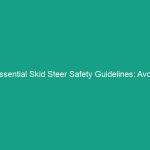Introduction
The landscape of drilling operations is constantly evolving, particularly in light of growing environmental concerns and the need for sustainable practices. This shift underscores the importance of Health, Safety, and Environment (HSE) protocols that not only prioritize Workplace Safety but also address the broader implications of drilling activities on the environment. Implementing effective strategies for Environmental Impact and Mitigation in Drilling Operations is crucial for compliance with Regulations, safeguarding ecosystems, and enhancing community relations. This article provides a comprehensive overview of essential strategies that can be adopted to minimize the environmental footprint of drilling activities.
Regulatory Frameworks in Drilling Operations
Understanding the regulatory frameworks that govern drilling operations is fundamental for any organization aiming to achieve compliance and minimize environmental impacts. Various international, national, and local regulations dictate how drilling should be conducted, focusing on environmental protection and Sustainability.
International Regulations
Globally, organizations like the United Nations Environment Programme (UNEP) and the International Maritime Organization (IMO) set Standards that affect drilling operations. These regulations often require companies to conduct Environmental Impact Assessments (EIAs) prior to commencing any drilling activities. EIAs are critical as they provide a structured approach to evaluating the potential environmental impacts associated with proposed drilling projects.
National and Local Regulations
In addition to international regulations, national governments have their own set of laws that must be adhered to. For instance, in the United States, the Environmental Protection Agency (EPA) enforces regulations under the Clean Water Act and the Clean Air Act. Compliance with these regulations ensures that drilling operations are not only legal but also environmentally responsible. Local regulations may vary and can include specific requirements for waste disposal, water usage, and emissions controls.
Importance of Compliance
Compliance with these regulations is not just a legal requirement; it is also a fundamental aspect of corporate social responsibility. Companies that adhere to environmental regulations often find that they build better relationships with local communities and stakeholders, leading to a more favorable operational environment.
Best Practices for Environmental Impact and Mitigation in Drilling Operations
Implementing Best Practices is essential for minimizing the environmental impact of drilling operations. These practices not only enhance Safety but also help to preserve the surrounding ecosystems and maintain the integrity of local resources.
Environmental Management Systems (EMS)
An effective way to manage environmental impact is through the establishment of an Environmental Management System (EMS). An EMS provides a framework for organizations to identify, monitor, and control their environmental performance. It involves setting environmental objectives, implementing Procedures to meet these objectives, and regularly reviewing progress. This systematic approach enables organizations to continuously improve their environmental performance and ensure compliance with relevant regulations.
Training and Awareness Programs
Training personnel in environmental Best Practices is vital. Employees must be aware of the potential environmental impacts of their actions and the importance of adhering to established protocols. Regular Training sessions can cover topics such as spill response, waste management, and the correct use of equipment to minimize emissions. By fostering a culture of environmental awareness, companies can significantly reduce their environmental footprint.
Innovative Technologies
The adoption of innovative technologies can greatly enhance the efficiency and sustainability of drilling operations. For example, advancements in directional drilling techniques minimize surface disturbance and reduce the amount of land impacted by drilling activities. Additionally, the use of real-time monitoring technologies can help detect leaks or other environmental Hazards early, allowing for prompt corrective actions.
Waste Management Strategies
Effective waste management is a critical component of Environmental Impact and Mitigation in Drilling Operations. Companies should develop comprehensive waste management plans that outline how different types of waste (e.g., hazardous, non-hazardous, recyclable) will be handled. Practices such as reducing, reusing, and recycling materials can significantly decrease the volume of waste generated during drilling operations.
Case Studies of Successful Mitigation Strategies
Real-world examples can provide valuable insights into effective environmental impact mitigation strategies in drilling operations. Studying these cases helps organizations learn from both successes and challenges faced by others.
Case Study: Shell’s Appomattox Project
Shell’s Appomattox project in the Gulf of Mexico is a prime example of innovative drilling operations that prioritize environmental considerations. The project integrated advanced technologies, such as subsea processing and floating production systems, to minimize the environmental impact. By reducing the need for surface facilities, Shell has effectively limited the ecological footprint of its operations.
Case Study: BP’s Thunder Horse Project
BP’s Thunder Horse project also illustrates the successful implementation of environmental best practices. BP has employed extensive monitoring systems to track emissions and discharges, allowing for real-time adjustments and compliance with environmental standards. The project has demonstrated that proactive environmental management can coexist with efficient drilling operations.
Challenges in Environmental Management
While there are numerous strategies and best practices available, the implementation of effective environmental management in drilling operations often faces several challenges. Recognizing these challenges is the first step toward overcoming them.
Technological Limitations
Despite advancements in technology, some drilling operations still face limitations that hinder effective environmental management. For instance, older drilling rigs may not be equipped with the latest emissions control technologies, which can lead to higher emissions and greater environmental risks. Upgrading equipment can be costly and time-consuming, presenting a significant barrier to compliance.
Regulatory Changes
The regulatory landscape is constantly shifting, which can make compliance more challenging for drilling operators. New regulations may be introduced with little warning, requiring companies to quickly adapt their practices. Staying informed about regulatory changes and engaging with policymakers can help organizations anticipate and respond to new requirements effectively.
Community Opposition
Community opposition to drilling projects can also pose significant challenges. Local populations may be concerned about potential environmental impacts, leading to protests or legal challenges. Engaging with communities early in the planning process and addressing their concerns can help mitigate opposition and foster positive relationships.
Future Trends in Environmental Impact Mitigation
As the drilling industry continues to evolve, so too will the strategies for mitigating environmental impact. Several key trends are emerging that may shape the future of environmental management in drilling operations.
Increased Use of Renewable Energy
One significant trend is the increased use of renewable energy sources in drilling operations. Companies are beginning to explore the potential of solar and wind power to reduce reliance on fossil fuels, thus decreasing emissions associated with drilling activities. This shift not only addresses environmental concerns but also aligns with global efforts to transition to more sustainable energy practices.
Enhanced Data Analytics
The rise of big data and advanced analytics is transforming how drilling operations are managed. Companies are leveraging data analytics to optimize drilling processes, reduce waste, and improve overall efficiency. By analyzing data from various sources, operators can make informed decisions that benefit both operational performance and environmental outcomes.
Collaboration and Knowledge Sharing
Collaboration among industry stakeholders is becoming increasingly important. By sharing knowledge and best practices, companies can collectively address environmental challenges and improve overall industry standards. Initiatives such as industry forums and partnerships can facilitate this exchange of information, leading to innovative solutions for environmental impact mitigation.
Conclusion
In conclusion, the importance of HSE in drilling operations cannot be overstated. Implementing effective strategies for Environmental Impact and Mitigation in Drilling Operations is essential not only for compliance with regulations but also for the preservation of our environment and the well-being of communities. By understanding regulatory frameworks, adopting best practices, learning from case studies, addressing challenges, and keeping an eye on future trends, organizations can significantly reduce their environmental footprint. It is imperative that industry leaders take proactive steps to prioritize environmental management in their operations. The time to act is now—let’s work together to create a more sustainable future for drilling operations.


